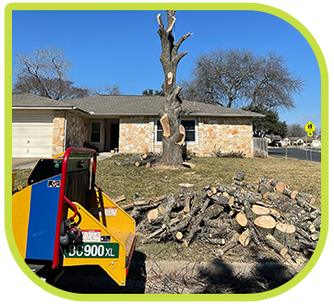 Tree maintenance experts can help you know how to prune Tree maintenance experts in Round Rock and Austin TX can help you improve your landscape. Tree pruning is a fundamental practice in arboriculture, serving as a cornerstone for maintaining the health, aesthetics, and safety of trees. While it may seem like a straightforward task, proper pruning requires knowledge of tree biology, growth patterns, and pruning techniques. In this article, we delve into the basics of tree pruning as an essential practice for tree maintenance.
Key Principles and Techniques of Tree Pruning While the benefits of tree pruning are clear, achieving desired outcomes requires adherence to key principles and techniques. Understanding these fundamentals is essential for effectively managing tree growth and health through pruning practices.
In conclusion, tree pruning is a critical practice for maintaining the health, aesthetics, and safety of trees in urban and natural environments. By understanding the importance of pruning, adhering to key principles and techniques, and considering the unique characteristics of tree species, arborists and homeowners can effectively manage tree growth and promote the long-term vitality of their landscapes. Hire the best tree maintenance experts in Round Rock and Austin TX Leaf Tree Services is your locally owned professional tree service with certified arborists for residential and commercial customers in Round Rock, Austin, and surrounding Central Texas areas. You can trust your trees to us. Contact us today to schedule a consultation, at 512-670-6766.
0 Comments
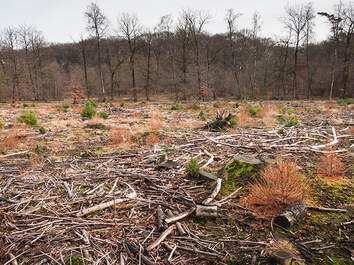 Land clearing experts can help you understand the entire process Land clearing in Round Rock and Austin TX can help you understand all you need to know about the process. This is an essential aspect of property management and development. Whether you're preparing a site for construction, agricultural purposes, or reclaiming overgrown land, the process involves removing vegetation, trees, rocks, and other obstacles from the area. At Leaf Tree Services, we understand the importance of clearing and have compiled a list of frequently asked questions to help you better understand the process. 1. What is Land Clearing? This refers to the removal of vegetation, trees, debris, and other obstacles from a designated area of land. This process is typically done to prepare the land for various purposes, including construction, agriculture, landscaping, and fire prevention. 2. Why is Land Clearing Necessary? This is necessary for several reasons. Firstly, it creates space for development projects such as building construction, roadways, or agricultural fields. Secondly, it helps improve land usability by removing overgrown vegetation and invasive species. Additionally, clearing can enhance property aesthetics and increase property value. 3. What Methods are Used for Land Clearing? There are several methods used for clearing, depending on the size of the area, the type of vegetation, and the intended land use. Some common methods include:
Each method has its advantages and is chosen based on the specific requirements of the project. 4. Is Land Clearing Harmful to the Environment? While it can have environmental impacts, such as habitat disruption and soil erosion, it can be done responsibly to minimize these effects. At Leaf Tree Services, we prioritize sustainable land management practices and take measures to minimize environmental damage during the clearing process. This may include selective clearing to preserve native vegetation, erosion control measures, and reforestation efforts. 5. How Long Does Land Clearing Take? The duration of clearing depends on various factors, including the size of the area, the density of vegetation, and the chosen clearing method. Small-scale clearing projects may be completed in a matter of days, while larger projects may take weeks or even months to complete. Our team at Leaf Tree Services works efficiently to complete projects promptly while ensuring quality results. 6. What Happens to the Cleared Vegetation? After vegetation is cleared from the land, it can be repurposed or disposed of in several ways. In some cases, the cleared vegetation may be chipped or mulched and used for landscaping, erosion control, or biomass energy production. Alternatively, it may be transported to a designated disposal site for composting or landfilling. 7. Do I Need Permits for Land Clearing? The need for permits for clearing varies depending on local regulations and the scale of the project. In some areas, minor clearing activities may not require permits, while larger-scale projects may necessitate environmental assessments and permits from local authorities. It's essential to consult with a professional land-clearing service like Leaf Tree Services to ensure compliance with all applicable regulations. 8. How Much Does Land Clearing Cost? The cost of this depends on several factors, including the size of the area, the complexity of the terrain, the chosen clearing method, and any additional services required. At Leaf Tree Services, we provide competitive pricing tailored to each project's specific requirements. We offer free consultations and estimates to help our clients understand the costs involved upfront. 9. Can Land Clearing Services Remove Stumps and Roots? Yes, many of this services, including Leaf Tree Services, offer stump and root removal as part of their services. Stump grinding or excavation equipment is used to remove stumps and roots from the cleared area, ensuring a clean and level surface for further development or landscaping. 10. How Can I Schedule a Land Clearing Service? Scheduling a land-clearing service with Leaf Tree Services is easy! Simply contact us through our website or give us a call to discuss your project requirements and schedule a consultation. Our experienced team will assess your needs, provide personalized recommendations, and work with you to develop a plan that meets your goals and budget. 11. What measures are taken to prevent erosion during land clearing? Erosion control is a crucial aspect of clearing to prevent soil loss and maintain environmental stability. Techniques such as installing silt fences, erosion control blankets, and vegetative stabilization using grasses or ground cover can help mitigate erosion risks during and after the clearing process. 12. Are there any alternatives to traditional land-clearing methods? Innovative techniques such as low-impact clearing, which minimizes disturbance to the soil and surrounding vegetation, are gaining popularity in environmentally sensitive areas. Additionally, advancements in technology have led to the development of specialized equipment and methods designed to reduce the ecological footprint of land-clearing operations. 13. What are the long-term effects of land clearing? While this is necessary for various purposes, it can have long-term impacts on ecosystems, including habitat loss, soil degradation, and changes in water flow patterns. Implementing restoration measures such as reforestation, soil stabilization, and habitat enhancement can help mitigate these effects and promote ecological resilience over time. 14. Can land clearing improve property value? Properly executed land-clearing projects can enhance the aesthetic appeal, functionality, and marketability of properties by creating usable space, improving access, and enhancing views. However, it's essential to consider the potential impacts on natural features, such as mature trees and wildlife habitats, and balance development goals with environmental conservation efforts. 15. What ongoing maintenance is required after land clearing? Depending on the intended use of the cleared land, ongoing maintenance may be necessary to control vegetation regrowth, manage erosion, and preserve soil health. Regular inspections, monitoring, and maintenance activities such as mowing, mulching, and replanting can help sustain the benefits of clearing in the long term. Hire the best-rated land-clearing experts in Round Rock and Austin TX Leaf Tree Services is your locally owned professional tree service with certified arborists for residential and commercial customers in Round Rock, Austin, and surrounding Central Texas areas. You can trust your trees to us. Contact us today to schedule a consultation, at 512-670-6766. 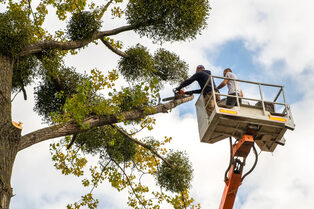 Tree care experts can help maintain trees all year round Tree care in Round Rock and Austin TX can help maintain your trees all year round. As the seasons change, so do the needs of our trees. Each phase of the year presents unique challenges and opportunities for tree care. In this article, we'll explore how tree care needs evolve across the seasons. Spring: A Time for Renewal As the winter chill begins to fade away, spring breathes new life into the natural world. Trees, emerging from dormancy, start to show signs of growth. However, this transition period requires careful attention from tree owners to ensure the health and vitality of their green companions.
Summer: Nurturing Through the Heat As summer sets in with its longer days and warmer temperatures, trees face the challenge of conserving moisture and withstanding heat stress. Tree care during this season focuses on providing support and protection to help trees thrive in the summer heat.
By understanding and addressing the evolving needs of trees throughout spring and summer, tree owners can nurture healthy, resilient specimens that enhance the beauty and biodiversity of their surroundings. Autumn: Preparing for Dormancy Autumn is a time of transition as trees prepare for dormancy. While the days grow shorter and temperatures begin to drop, there are several key tasks tree owners can undertake to help their trees thrive during this season of change.
Winter: Providing Support Through the Cold Winter poses unique challenges for trees as they enter dormancy and face exposure to harsh weather conditions. Careful attention during this season can help trees withstand the cold and emerge strong and healthy in the spring.
By adapting tree care practices to meet the changing needs of trees throughout autumn and winter, tree owners can provide the support and protection necessary for their trees to thrive year-round. Remember, caring for trees is a long-term commitment that rewards both the environment and future generations with beauty, shade, and biodiversity. Hire the best tree care services in Round Rock and Austin TX Leaf Tree Services is your locally owned professional tree service with certified arborists for residential and commercial customers in Round Rock, Austin, and surrounding Central Texas areas. You can trust your trees to us. Contact us today to schedule a consultation, at 512-670-6766. 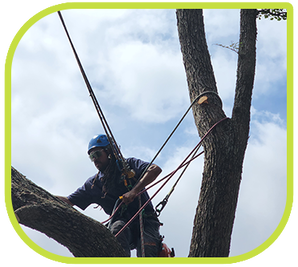 Tree care services can help maintain a healthy ecosystem Tree care services in Round Rock and Austin TX can help deal with invasive species. Invasive species pose a significant threat to ecosystems worldwide, often outcompeting native species and disrupting delicate ecological balances. These non-native organisms, whether plants, animals, fungi, or microbes, can spread rapidly and cause considerable damage to the environment, economy, and human health. Addressing invasive species requires a multi-faceted approach, and tree care experts play a crucial role in managing the impact of invasive species on forests and urban green spaces. Invasive species typically thrive in environments where they encounter minimal natural predators or competitors, allowing them to proliferate unchecked. Factors such as global trade, travel, and climate change contribute to the spread of these species, as they are often introduced to new areas unintentionally. Once established, invasive species can outcompete native flora and fauna for resources such as sunlight, water, and nutrients, leading to biodiversity loss and ecosystem degradation. In forests, invasive plants like kudzu, Japanese knotweed, and tree-of-heaven can quickly overtake native vegetation, choking out trees and other plants essential for wildlife habitat. In urban areas, invasive insects such as the emerald ash borer and the Asian long-horned beetle pose threats to tree health, causing widespread damage and economic losses. Additionally, invasive pathogens like sudden oak death and Dutch elm disease can devastate entire tree populations, altering landscapes and reducing the ecological services provided by trees, such as carbon sequestration and air purification. The Role of Tree Care Experts Tree care experts play a vital role in managing the impact of invasive species on forests, parks, and urban landscapes. These professionals possess the knowledge, skills, and tools necessary to identify invasive species, assess their impact on tree health, and develop effective management strategies. Here are some ways in which tree care experts can help combat invasive species:
Leaf Tree Services: Leaders in Invasive Species Management In the fight against invasive species, tree care companies like Leaf Tree Services play a pivotal role in implementing effective management strategies and preserving the health of our natural landscapes. Leaf Tree Services, based in Austin, Texas, is renowned for its expertise in tree care and commitment to environmental stewardship. Let's delve into how Leaf Tree Services can help deal with invasive species:
By leveraging their expertise, resources, and dedication to environmental sustainability, Leaf Tree Services stands at the forefront of invasive species management, making significant contributions to the preservation of our natural landscapes. In conclusion, the threat posed by invasive species requires proactive and concerted efforts from all stakeholders, including tree care professionals like Leaf Tree Services. Through their specialized knowledge, integrated pest management solutions, state-of-the-art equipment, and commitment to community engagement, Leaf Tree Services plays a vital role in safeguarding our ecosystems from the detrimental effects of invasive species. As we continue to confront this global challenge, the expertise and dedication of companies like Leaf Tree Services are indispensable in preserving the health and resilience of our natural world. Hire the best-rated tree care services in Round Rock and Austin TX Leaf Tree Services is your locally owned professional tree service with certified arborists for residential and commercial customers in Round Rock, Austin, and surrounding Central Texas areas. You can trust your trees to us. Contact us today to schedule a consultation, at 512-670-6766. 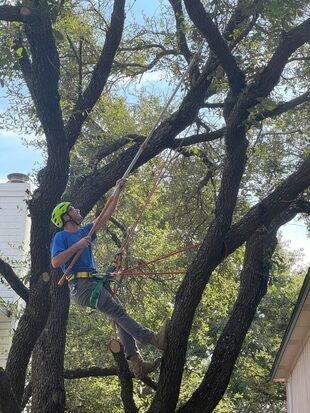 Tree Service can help deal with tree damage after a winter storm Tree Service in Round Rock and Austin TX can help you deal with tree damage after a Winter storm. Winter storms can wreak havoc on trees, leaving behind a trail of destruction that homeowners must contend with. Whether it's heavy snow, ice accumulation, or strong winds, these weather events can cause branches to break, trunks to split, or even entire trees to topple over. Dealing with tree removal after damage from a winter storm requires careful assessment and planning to ensure safety and minimize further harm to property or individuals.
Tree Removal Techniques and Aftercare After assessing the damage and planning the removal process, it's time to take action to safely remove the damaged tree and address any potential hazards or obstacles. Here are some techniques and considerations for dealing with tree removal after damage from a winter storm: 1. Hire a Professional While DIY tree removal may seem like a cost-effective option, it can be dangerous and is not recommended for trees with extensive damage or those located near structures or power lines. Hiring a professional arborist or tree removal service ensures that the job is done safely and efficiently, minimizing the risk of accidents or further property damage. 2. Use Proper Equipment If you do decide to tackle tree removal on your own, make sure you have the proper equipment and protective gear. Chainsaws, ropes, ladders, and safety harnesses are essential tools for safely removing trees. Wear protective clothing, including gloves, goggles, and a hard hat, to protect yourself from falling debris and other hazards. 3. Practice Safe Cutting Techniques When using a chainsaw to cut down a damaged tree, follow safe-cutting techniques to prevent accidents. Make sure the chainsaw is sharp and well-maintained, and always cut at a slight angle to prevent the trunk from splitting and causing kickback. Cut the tree into manageable sections to facilitate removal and disposal. 4. Dispose of Debris Properly Once the tree has been removed, it's important to dispose of the debris properly. Branches, limbs, and other organic materials can be chipped or composted for mulch or other landscaping purposes. Larger pieces of wood can be salvaged for firewood or disposed of at a designated landfill or recycling center. Avoid burning tree debris unless permitted by local regulations and take care to prevent the spread of invasive pests or diseases. 5. Assess and Address Remaining Trees After removing the damaged tree, take the time to assess the health and stability of any remaining trees on your property. Prune any damaged or weakened branches to reduce the risk of future storm damage, and consider consulting with a professional arborist for advice on tree maintenance and care. Investing in preventive measures such as regular pruning, fertilization, and tree inspections can help protect your property from future storm damage and ensure the health and longevity of your trees. Dealing with tree removal after damage from a winter storm can be a challenging and potentially hazardous task, but with careful assessment, planning, and execution, you can safely remove damaged trees and minimize the risk of further damage to your property. Whether you choose to hire a professional tree removal service or tackle the job yourself, prioritizing safety and proper technique is essential for a successful outcome. Work with the most experienced Tree Service in Round Rock and Austin TX Leaf Tree Services is your locally owned professional tree service with certified arborists for residential and commercial customers in Round Rock, Austin, and surrounding Central Texas areas. You can trust your trees to us. Contact us today to schedule a consultation, at 512-670-6766. 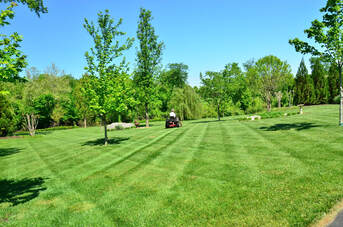 Tree maintenance experts can help you eradicate frozen trees Tree maintenance in Round Rock and Austin TX can help you deal with frozen trees. Winter transforms landscapes into breathtaking scenes, with snow-covered landscapes and frosted trees painting a picturesque picture. However, behind this beauty lies the reality of the challenges faced by trees during the colder months. Frozen trees are a common sight in winter, and understanding the impact of freezing temperatures on trees is crucial to their well-being. In this first part, we'll delve into the phenomenon of frozen trees and the challenges they face. 1. Why Do Trees Freeze? Trees, like all living organisms, are affected by extreme temperatures. During winter, when temperatures drop below freezing, trees are at risk of freezing. This occurs because water within the tree's cells expands as it freezes, causing damage to cell walls and disrupting essential processes. 2. Effects of Freezing on Trees When trees freeze, several detrimental effects can occur:
3. Species Susceptibility Not all trees are equally susceptible to freezing temperatures. Evergreen trees, such as pines and spruces, are more resilient due to their needle-like leaves and waxy coatings, which help reduce water loss. Deciduous trees, on the other hand, are more vulnerable as they shed their leaves, leaving their branches exposed. 4. Signs of Frozen Trees Identifying frozen trees is essential for timely intervention. Signs include:
How a Tree Service Expert Can Help with Frozen Trees While winter poses challenges for trees, there are ways to mitigate the effects of freezing temperatures with the help of tree service experts. In this second part, we'll explore the role of tree service professionals in caring for frozen trees and preserving their health. 1. Pruning and Trimming One of the most effective methods to prevent winter damage is through proper pruning and trimming. Tree maintenance experts can remove dead or damaged branches before winter, reducing the risk of breakage due to ice accumulation. Strategic pruning also improves air circulation within the canopy, reducing the likelihood of fungal infections. 2. Anti-Desiccant Treatments To protect evergreen trees from winter burns, tree service professionals may apply anti-desiccant sprays. These treatments create a thin, protective layer on the foliage, reducing moisture loss and minimizing damage from freezing temperatures and harsh winds. 3. Structural Support For trees at risk of branch failure due to heavy ice or snow accumulation, tree maintenance experts can provide structural support. This may include cabling or bracing weak branches to prevent them from breaking under the weight of ice or snow, thereby safeguarding the tree's integrity. 4. Soil Care Maintaining healthy soil conditions is crucial for tree survival during winter. Tree service professionals can assess soil moisture levels and recommend appropriate measures to improve drainage and aeration. Mulching around the base of trees also helps insulate roots and retain soil moisture. 5. Emergency Response In cases where trees suffer severe winter damage, prompt intervention is essential. Tree maintenance experts are equipped to handle emergency situations, such as fallen trees or large branches blocking roads or structures. Their expertise and specialized equipment ensure the safe and efficient removal of debris, minimizing further damage. 6. Winter Tree Inspection Before the onset of winter, tree service experts conduct thorough inspections to identify potential risks and vulnerabilities. They assess the overall health and structural integrity of trees, identifying weak branches, signs of disease, and other issues that could worsen during winter. This proactive approach allows for targeted interventions to prevent winter damage. 7. Snow and Ice Removal Heavy snow and ice accumulation can pose significant risks to trees, causing branches to bend or break under the weight. Tree service professionals are trained in safe snow and ice removal techniques, using specialized equipment to carefully dislodge snow and ice from branches without causing further damage. Prompt removal helps alleviate stress on trees and prevents structural failure. 8. Winter Watering While it may seem counterintuitive, trees still require adequate hydration during winter, especially evergreens. Tree service experts can assess soil moisture levels and recommend supplemental watering if necessary, ensuring that trees remain sufficiently hydrated throughout the dormant season. Proper hydration helps trees withstand freezing temperatures and maintain their health and vigor. 9. Disease and Pest Management Winter provides an opportunity for tree service professionals to address underlying issues related to pests and diseases. Many pests and pathogens are dormant during winter but can still pose threats to trees. Tree service experts may apply preventive treatments or recommend cultural practices to mitigate the risk of infestations and infections, safeguarding tree health throughout the winter months. 10. Education and Guidance Beyond providing hands-on care for frozen trees, tree service professionals play a crucial role in educating property owners about winter tree care practices. They offer guidance on how to protect trees from winter damage, such as proper mulching techniques, selecting cold-hardy tree species, and minimizing salt exposure. By empowering property owners with knowledge, tree service experts foster a culture of proactive tree care and stewardship. Frozen trees in winter present unique challenges that require specialized care and expertise. Tree service professionals play a vital role in mitigating the effects of freezing temperatures, preserving tree health, and enhancing the resilience of urban and natural landscapes. Through proactive measures, such as pruning, anti-desiccant treatments, and emergency response, tree service experts ensure that trees thrive even in the most challenging winter conditions. By recognizing the importance of their role and leveraging their knowledge and skills, we can protect and sustain our precious arboreal resources for generations to come. Hire the best tree maintenance services in Round Rock and Austin TX Leaf Tree Services is your locally owned professional tree service with certified arborists for residential and commercial customers in Round Rock, Austin, and surrounding Central Texas areas. You can trust your trees to us. Contact us today to schedule a consultation, at 512-670-6766. |
Leaf Tree ServicesLocally owned full service professional tree care serving residential and commercial customers in Austin and surrounding areas for over 20 years. Archives
June 2024
Categories
All
|

 RSS Feed
RSS Feed
